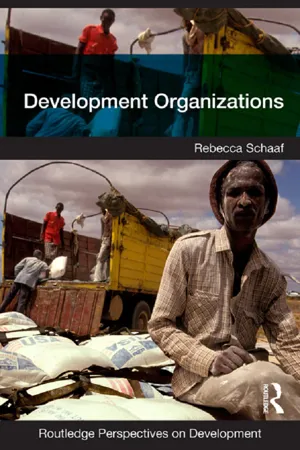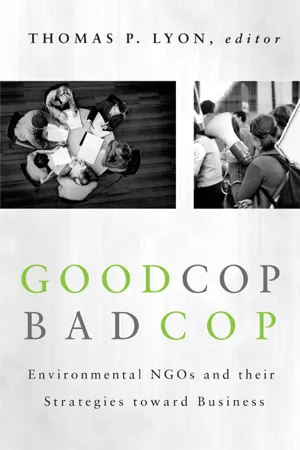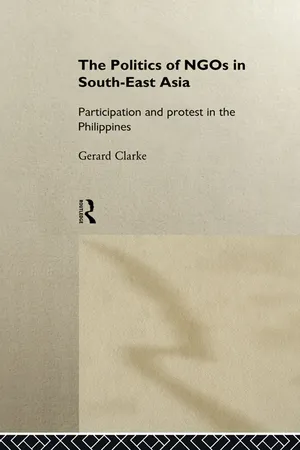Social Sciences
Non-governmental Organisations
Non-governmental organizations (NGOs) are private, non-profit entities that operate independently of government control. They are typically driven by a specific social or political goal, such as humanitarian aid, environmental conservation, or human rights advocacy. NGOs often rely on donations and volunteer work to support their activities and are influential in addressing social issues and providing services to communities.
Written by Perlego with AI-assistance
Related key terms
7 Key excerpts on "Non-governmental Organisations"
- eBook - ePub
- Rebecca Schaaf(Author)
- 2013(Publication Date)
- Routledge(Publisher)
6 International non-governmental organizationsLearning goalsIntroduction- To understand the changing role of non-governmental organizations in the development process.
- To critique the strategies and activities of international NGOs.
- To understand the key concepts of participation, empowerment and sustainability in relation to NGO activities and goals.
- To understand a rights-based approach to development.
- To recognize the key challenges and opportunities facing international NGOs in the twenty-first century including their relationship with other development organizations.
The twentieth century saw the rise of the international non-governmental organization. These large organizations are now household names, with staff and offices across the globe, significant financial and political power and an important role to play in the development process. This chapter charts the rise of the international non-governmental organization (INGO), considers their strengths and weaknesses, reviews the challenges and opportunities they face and evaluates the implications of their relationships with other development organizations. The chapter links into Chapter 7 , which considers the range of smaller NGOs, community-based organizations and civil society actors that are underpinned by a similar philosophy on development.NGOs form part of civil society, or the third sector: outside the state and the market. The third sector includes families, churches, clubs, political parties, professional associations, participatory organizations and NGOs (Brett 2000). They are private because they do not depend on the coercive power of the state, but unlike private-sector firms associated with the free market, they do not depend on self-interest and the pursuit of money and profits. Instead, they depend on charitable giving and funding from governmental and private organizations. They are formal and self-governing, with some degree of voluntarism in terms of staff or management involvement (Lewis and Kanji 2009). Within the development sector, they have increasingly adopted the role of service delivery agencies (and have been taken seriously in that role), particularly from the 1980s onwards. They are also associated with the promotion of change, whether social, economic or political (Lewis and Kanji 2009). International NGOs have offices in many different countries and a global scope to their activities. The next section considers the significant growth in numbers of INGOs over the past 150 years. - eBook - ePub
Non-Governmental Organizations in World Politics
The Construction of Global Governance
- Peter Willetts(Author)
- 2010(Publication Date)
- Routledge(Publisher)
3 Different ways of thinking about what groups are or are not NGOs, including the UN definition of NGOs, will be discussed in this chapter. Then how NGOs participate in the UN system will be discussed in the next chapter.Narrow definitions of non-governmental organizations in global diplomacy
NGOs are often presumed to be concerned with development, humanitarian work, the environment, or human rights. Then, they may be categorized into operational groups that run their own projects or advocacy groups that seek to influence policy. Not surprisingly, such an approach appears in the definitions used by intergovernmental organizations concerned with development. A variety of restrictive definitions of non-governmental organizations is reported in Box 1.1 .Box 1.1 Competing restrictive definitions of non-governmental organizations• “An organization which seeks funding, hires staff, and undertakes programs, but does not realize a profit”—UN Food and Agriculture Organization (FAO) Forestry Department.1• “NGOs include a wide variety of groups and institutions that are entirely or largely independent of government, and characterized primarily by humanitarian or cooperative, rather than commercial, objectives”—World Bank, 1989.2• “People’s organizations can be defined as democratic organizations that represent the interests of their members and are accountable to them … Nongovernmental organizations can be defined as voluntary organizations that work with and very often on behalf of others”—United Nations Development Programme (UNDP), 1993.3• “An NGO is a private, voluntary, not-for-profit organization, supported at least in part by voluntary contributions from the public. For Development Co-operation Report purposes, an - David Lewis(Author)
- 2014(Publication Date)
- Routledge(Publisher)
As we saw earlier, the term ‘non-governmental organization’, which tends to be applied mainly (though not exclusively) either to third sector organizations that work internationally or to those active in developing country contexts, has its roots in the UN system that was established after the Second World War. The designation ‘NGO’ was originally given to international non-state organizations that were awarded consultative status in UN activities. For the OECD's Development Assistance Committee (DAC), an NGO is defined as ‘any non-profit entity without significant government-controlled participation or representation’ (OECD 2011: 6).However, organizations that are termed NGOs in one country may be termed differently in another, often arbitrarily for no apparent reason other than that of history and tradition. For example, ‘voluntary organization’ or ‘charity’ are the terms that are widely used in the UK where there is a rich tradition of voluntary work and volunteering and a history of charity law which emphasizes Christian, and sometimes paternalistic, values. ‘Non-profit organization’ is more commonly used in the US, where the market rather than the state has long been the dominant institution, and where alternative forms of social organization can receive fiscal benefits if they can demonstrate that they are not commercial, profit-making entities.There is no straightforward way to find a path through the terminological mire of the world's third sector organizations. But it helps to recognize that each of the above terms may be culturally generated, with usage historically traceable back to a specific social, economic and political context. This is more than just a semantic problem, because labelling has important resource and policy implications in terms of ‘who is in and who is out’, and ‘who gets what’. In order to illustrate the terminological problem, Najam (1996b : 206) drew up a list of 48 different acronyms used for various kinds of NGO by practitioners and researchers all over the world, and even this list, as the author states, is far from exhaustive! I have added a few more in Table 4.1 .If each of these terms was used logically and consistently, then this might prove useful in providing a way of categorizing different types of third sector organization. But they are rarely deployed consistently. In Britain, the term ‘voluntary organization’ might typically be employed to refer to an organization working with the homeless in London, while a similar organization working with the homeless in India is likely to be termed a ‘non-governmental organization’. In the United States, the term ‘non-profit organization’ covers many of the third sector organizations working domestically, but ‘private voluntary organization’ has traditionally been used within the USAID to refer to US non-profit organizations working overseas. Each term tends to be popular with some organizations but disliked by others. For example, some non-governmental organizations in developing countries resent the label ‘voluntary’ because they feel it detracts from the professionalized character of organizations that may not use volunteers, while others may dislike ‘non-profits’ because it makes them sound too business-like. Even the term NGO has become unpopular in some countries because it is associated with corruption. It is also often pointed out that one of the problems with the ‘non-governmental’ tag is that it lacks precision because it attempts to describe organizations by what they are not instead of by what they are- eBook - ePub
A Foucauldian Approach to International Law
Descriptive Thoughts for Normative Issues
- Leonard M. Hammer(Author)
- 2016(Publication Date)
- Routledge(Publisher)
14 International actors along with local groups linked to for example ethnic, cultural, or religious identities (to name but a few) recognise their position and local conditions as inherently relevant and defining, such as to move away from a universal doctrine. What has resulted however is that a variety of non-state public organizations, especially nongovernmental organizations, have begun to play a rather active role within the global civil society framework due to the scope of their operations, the broad format of their fieldwork, and the ability to infuse the international process with greater transparency.With greater communication capabilities due to significant technological innovations, and the claim to moral legitimacy on the basis of representing public opinion of a variety of groups, non-governmental organizations have risen as important actors in the international framework.15 The need for some form of governance and oversight over the globalised free market, even within various international bodies that have served to regulate international markets like the World Trade Organisation, have tended to reference non-governmental organizations as a means of rounding-out their decisions and ensuring for access to all forms of information.16 Non-governmental organizations also have become more assertive in the development of international documents, participating in the monitoring and implementation of norms and engaging the variety of existing dispute resolution processes.17 Thus, non-governmental organizations are actively involved in both the decision making process of international law (especially codification initiatives) along with the enforcement aspects.18Non-governmental organizations’ emotional and frank form of engaging international discourse moves the context outside of the state19 given the emergence of civil society as an important linchpin in the international process and recognizing the influence that non-governmental organizations have on the state as well as within international bodies.20 Non-governmental organizations go beyond the role of the state in given situations by enhancing the capacity of international organizations (and states) due to international networking and local understanding, enhanced relationship with the local population, willingness to take on difficult projects, and greater flexibility (such as capacity to address transnational issues).21 Non-governmental organizations then serve to create and constitute state identities and interests in an active sense22 - eBook - ePub
Good Cop/Bad Cop
Environmental NGOs and Their Strategies toward Business
- Thomas Lyon(Author)
- 2012(Publication Date)
- Routledge(Publisher)
PART II HOW DO SOCIAL SCIENTISTS UNDERSTAND NGOS?Passage contains an image CHAPTER 3 CIVIL SOCIETY AND THE ENVIRONMENT: UNDERSTANDING THE DYNAMICS AND IMPACTS OF THE U.S. ENVIRONMENTAL MOVEMENT
Robert J. Brulle and J. Craig JenkinsN onprofit advocacy organizations provide a critical means by which citizens act together to pursue their common interests. The important role of NGOs has been verified by the sociology of social change, which long has studied the mechanisms by which large-scale change has occurred. This scholarship has identified the institutions based in civil society as key sites for the origination of social change (McAdam et al. 1996; Sztompka 1993). Civil society is constituted by voluntary institutions that exist outside the direct control of both the market and the state and comprises a number of different organizational forms, most notably NGOs. Because these organizations are based in the deliberations of their members, the institutional dynamics defined by market forces and the political power of the state are minimized in their operation. This independence is what allows civil society to serve as a locus for the generation of citizens’ action (Skocpol 2003). NGOs develop and advocate alternative discourses and practices, and then present these social problems and their solutions in the public arena. This puts social movement organizations at the center of the renewal and transformation of social institutions (Habermas 1979, 1996). Thus institutions based in civil society are seen as primary actors for the potential transformation of political and economic systems.Social movements historically have exerted influence over collective decisions through democratic debate in the public sphere (Habermas 1962), whose role is to serve as an arena that can “subject persons or affairs to public reason” and “make political decisions subject to appeal before the court of public opinion” (Habermas 1989, 141). The public sphere consists of open forums, such as university conferences, newspaper editorials, or internet bloggers. In these forums, debates and discussions can identify problems, develop possible solutions, and create sufficient political pressure to have them addressed by constitutional governments (Habermas 1996, 1998). This enables the realization of social learning based on democratic deliberation (Calhoun 1993) and is central to the identification phase of the policy life cycle described by John Maxwell in Chapter 5 - eBook - ePub
- Gerd Oberleitner(Author)
- 2013(Publication Date)
- Polity(Publisher)
7 NON-GOVERNMENTAL ORGANIZATIONSIndependence between Law and PoliticsOver the past half century, the spread of inter-governmental human rights institutions has been accompanied by the emergence of an ever greater number of non-governmental organizations devoted to the promotion and protection of human rights. The organization of individuals who pursue goals on the international level is not a new phenomenon and has been traced back to the mid-1800s (Charnovitz, 1997). The rapid growth of civil society movements, though, in particular in the field of human rights, is essentially a striking global phenomenon of the past decades (Rice and Ritchie, 1995: 245). From small, local, grassroots-level groups to worldwide membership organizations, from single-issue pressure groups to large networks, NGOs have become central to the world of human rights. A number of factors have accelerated this development, most recently the revolution in telecommunications and electronic media, which allows civil society groups around the globe to gather and share information and exert an influence which is sometimes way beyond their size or financial power.The 2004 Yearbook of International Organizations gives a total number of 7,306 international non-governmental organizations, a number which rises up to more than 13,600 when ‘internationally oriented national organizations’ and others are included, but it is less clear on the number of human rights NGOs. Indeed, there is no overall accepted definition for a ‘human rights NGO’. Even the very term ‘non-governmental organization’ is contested. Alston has rightly noted that defining them ‘in terms of what they are not combines impeccable purism in terms of traditional international legal analysis with an unparalleled capacity to marginalize a significant part of the international human rights regime’ (Alston, 2005: 3). There is no clear-cut distinction between ‘human rights NGOs’ and NGOs working in other areas. Some would say that the former include only organizations with the very raison d’être - eBook - ePub
- Gerard Clarke(Author)
- 2006(Publication Date)
- Routledge(Publisher)
Throughout the 1994–1997 period, tension over the peace talks and the upcoming elections led the CPP, the stronger of the coalition partners, to clamp down on opposition political parties and the media, creating uncertainty about the conditions under which the 1998 elections will be held, especially after the events of July 1997. NGOs were in part, victims of this tense climate. The government, especially the Cambodian People’s Party, resents the millions of dollars pumped by international donors into the NGO community amid cutbacks in government spending and civil service employment in 1996/97 and was wary of links between NGOs and opposition political parties. Similarly, in the provinces, local authorities are often unable to distinguish between NGOs and political parties and frequently take action against the former.Yet within this tense climate, the Cambodian NGO community also plays a strategic political role. The moribund character and desperate plight of the Cambodian economy and government reliance on international donor assistance prevents the government from taking action against the NGO community. In addition, the government has gradually begun to accept the political neutrality of leading NGOs and the positive role they play in complementing government services and in building civil society. As a result the government consulted NGOs on a draft law governing NGO activities in 1995 and 1996, a draft largely regarded by NGOs as positive and supportive.29 In addition, NGOs are assisting government agencies and foreign donors in developing a system of local government centred on village committees. In a state where trade unions and middle-class professional associations are largely government controlled, where grassroots organisations of farmers are almost non-existent, where the media is under constant threat, and where a private sector is only gradually emerging, NGOs therefore play a vital role in bolstering a fragile civil society. Cambodian NGOs, with their international counterparts continue to bolster the service provision function of the government. They also continue to train government officials in the skills needed to sustain a viable democracy, in areas such as human rights and the law, community organising and popular participation and in legislative reform. NGOs are promoting debate and discussion around difficult issues which have never before been the subject of popular debate, including child abuse, domestic violence, corruption, human rights violations, illegal timber exports and religious freedom. NGOs also plan to establish an election monitoring organisation, CONFREL (Committee for Free and Fair Elections) in time for the 1998 elections, modelled on the National Movement for Freedom of Elections in the Philippines (NAMFREL) and echoing the activities of similar organisations in Thailand and Indonesia.30
Learn about this page
Index pages curate the most relevant extracts from our library of academic textbooks. They’ve been created using an in-house natural language model (NLM), each adding context and meaning to key research topics.






